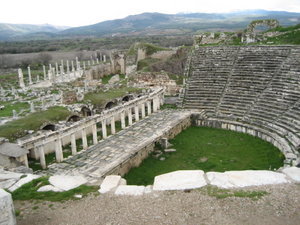Advertisement

 The Theater
The Theater
This same theater was used for gladiatorial combats.with the 2 goddesses associated with fertility. Artemis is the twin of the Greek God Apollo, usually represented with many breast-like protuberances to emphasize fertility, who is also revered as the Roman Goddess of hunting, Diana, or the Anatolyan Goddess Cybele. On the other hand, Aphrodite is the Greek Goddess of love and fertility. Her Roman equivalent is the Goddess Venus, more renowned for her beauty. She is the same goddess who has so inspired Boticelli's painting "Birth of Venus" on display at the Uffizi Galerry in Firenze, Italia. Just to carry this further, the famous son of Aphrodite aka Venus is Eros , aka Cupid, the God of love. Wow, didn't I really digress!
Back to Aphrodisias............My ramblings were unceremoniously disturbed upon hearing another group discuss "aphrodisiacs". I wanted to comment that yes, the root word may be that, but no, the place is called APHRODISIAS with an S, not with a C. Ugh,,,,,,, it must be the baklava. Or the yogurt mixed with honey and hashish. Yes, hashish. Now, seriously, let's get back to the discussion of Aphrodisias. Among cypress groves and fertile fields, one gets to enjoy the ancient splendour of Aphrodisias without the usual 
 The Marble from Aphrodisias
The Marble from Aphrodisias
Not from Carara,Italy....this one's from Turkiye!crowd found in Ephesus. Although this site is not too far from Kusadaci, it has mainly served only as a worthwhile stopover from Kusadaci/Ephesus to Pamukkale/Denizli. Must be a geographical misfortune, being sandwiched between one great ancient site and a natural wonder. Though one can cover Aphrodisias in just one afternoon, still......I am sure no one would mind spending a night somewhere near to do the site another round, another day. I tried sitting in one of the marble stone seats and enjoyed the view of the Great Meander. It was so refreshing to be a "lonesome tourist" here. So much tranquility, amidst all this history.
I was glad we were given enough time to explore the area as well as enjoy the art pieces from the Museum of Sculptures. The Sculptors' Workshop does not look much, but the marble art pieces inside it speak volumes of the kind of art that flourished in this place. We are told that only a mile away is the marble quarry site , much like Carara in Italy has become the mecca of such Renaissance artists/sculptors as Michelangelo and Leonardo da Vinci. The Museum is full of cult statues of Aphrodite, but the most interesting piece would have to be the Zoilo Frieze. This is a set of carved panels honoring Zoilo, a Roman citizen who was born a slave.
Just outside the Museum, one finds a number of sculptures seemingly left to the elements. A frieze here, a statue there. One of the tourists even managed to lie on her stomach , flat on top of one of the sculptures, to have her picture taken. The friezes outside the Workshop were all there for us to see, to touch, to photograph- with flash or no flash. You don't usually get these privileges elsewhere. So there......make that worthy stop , or make it an overnight stay , in Aphrodisias. Better still, bring a picnic basket and a flask of Turkish coffee or apple tea to enjoy while trying one of those stone seats. No yogurt with hashish, please.
Advertisement
Tot: 0.718s; Tpl: 0.012s; cc: 41; qc: 199; dbt: 0.278s; 1; m:domysql w:travelblog (10.17.0.13); sld: 1;
; mem: 1.6mb

















EuroTraveler
Jeff Titelius
Stunning photography!
You are so humorous..."wow, didn't I digress." I burst out laughing at this. And the yogurt and hashish...LOL!! I LOVED this article and all of its historical lessons. Actually, thoughts of highschool ancient history were running through my head..I used to love to learn about the gods... Although I am glad you got to be get up close and personal with the artifacts, I hope someday, they protect them from the elements and human handling or they'll be lost forever. You are a very talented photographer I must say...some of these photos are surrealistic!! Keep 'em coming, Lili!!